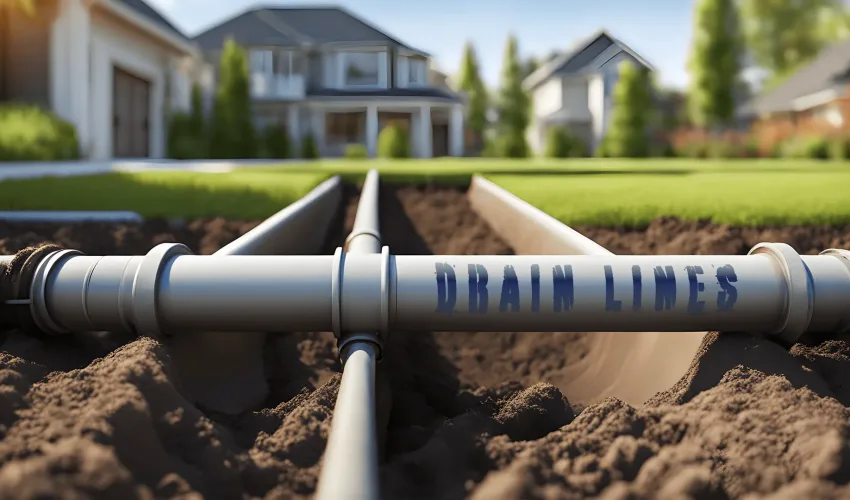A drain line is a specialized pipe within a building’s plumbing system that transports wastewater away from fixtures to a sewer or septic system, playing a pivotal role in ensuring the efficient and sanitary disposal of used water from activities like bathing, cooking, and cleaning. Often overlooked, it’s this very system that ensures that the wastewater is promptly carried away, safeguarding cleanliness and hygiene in our homes and businesses.
Despite their significance, we rarely consider them until a problem surfaces. These lines play a pivotal role in ensuring our homes function smoothly. Due to its complexity, it’s essential to understand its workings, maintenance requirements, and potential challenges. Using this insight, we can make sure that our homes’ drain networks are consistently performing well.
Maintaining drain lines is not just about addressing problems; it is an important task for homeowners. Just as we look after our living spaces, ensuring our unseen drain systems are in top condition is paramount. Recognizing the importance of drain lines can avert expensive repairs, extend the system lifespan, and promote healthy living. A well-maintained drain line signifies a well-cared-for home.
What is a Drain Line?
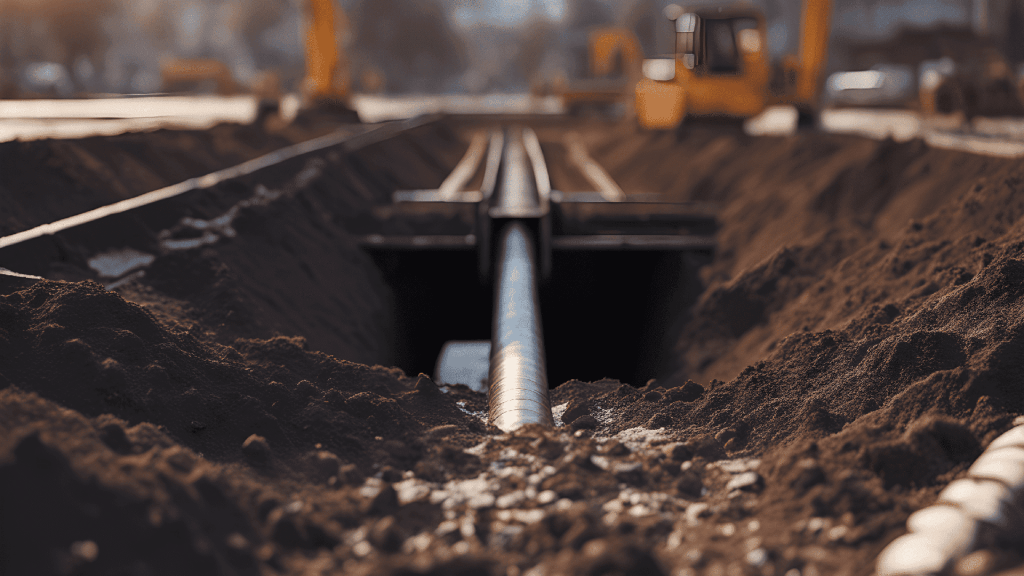
A drain line is the backbone of household sanitation. To better understand this system, we offer the following insight:
- Materials and Composition: The drain lines’ material often hinges on when the house was constructed. For its durability, PVC pipes, also known as vinyl, are commonly used in modern homes. Older structures might feature cast iron or even lead pipes. Each material has its benefits and challenges.
- Location and Access: Typically, drain lines are situated beneath homes, moving wastewater away to the larger sewer system. In larger residences, multiple drain lines might exist, but they eventually merge into a single exit. Often found near main fixtures, these lines can be accessed during repairs or inspections, often from places like basements.
- Regular Maintenance: The longevity of drain line is closely related to their maintenance. Household solutions like baking soda and vinegar can tackle minor issues. However, for an all-encompassing solution, enlisting a professional plumbing service is advisable. Their expertise ensures your drains are inspected, cleaned, and serviced to perfection.
- Common Challenges: Older pipes, especially those made of cast iron, may face wear and tear. Indicators of issues can range from slow water flow to unexpected backups. There is also the issue of root intrusion, which can cause severe problems.
- Inspection Importance: When buying a property, having the drain lines inspected can offer clarity on their condition. Professionals use advanced camera technology to visually inspect the internal state of these pipes, identifying any potential challenges.
- Evaluating Costs: The costs linked with drain line upkeep can fluctuate based on the problem’s complexity, the chosen remedy, and regional pricing variations. While routine maintenance might be affordable, extensive repairs or replacements can be costly. Engaging a plumbing service for a comprehensive quote guarantees a clear understanding of potential expenses.
The Importance of Maintaining a Drain Line
Benefits of Regular Maintenance
From unsavory smells to health risks, malfunctioning drain lines can cause significant problems. To prevent such complications and preserve hygiene, consistent maintenance is necessary.
Recommended Inspection Frequency
Every six months is an ideal interval for checking your drain system. Timely inspections can identify and fix potential problems before they become major, costly issues.
Three vital signs suggesting drain line problems include:
- Drain Clogs: Blockages in drains are common in homes. Nevertheless, frequent or severe clogs require attention. It is often necessary to use cable or ‘snake’ cleaning methods to remove particularly persistent obstructions.
- Slow Drainage: A reduced drainage speed, which can be indicated by water sitting in sinks or bathtubs, may indicate a deeper problem. Over time, particles like food particles and hair can accumulate, impeding water flow.
- Foul Smells: Unpleasant odors comings from drains typically indicate trapped and decaying garbage. This necessitates immediate action.
Early detection and repair can save homeowners from headaches and costly repairs. Regular checks, combined with professional expertise when needed, ensure your home’s drain lines remain in prime condition for years.
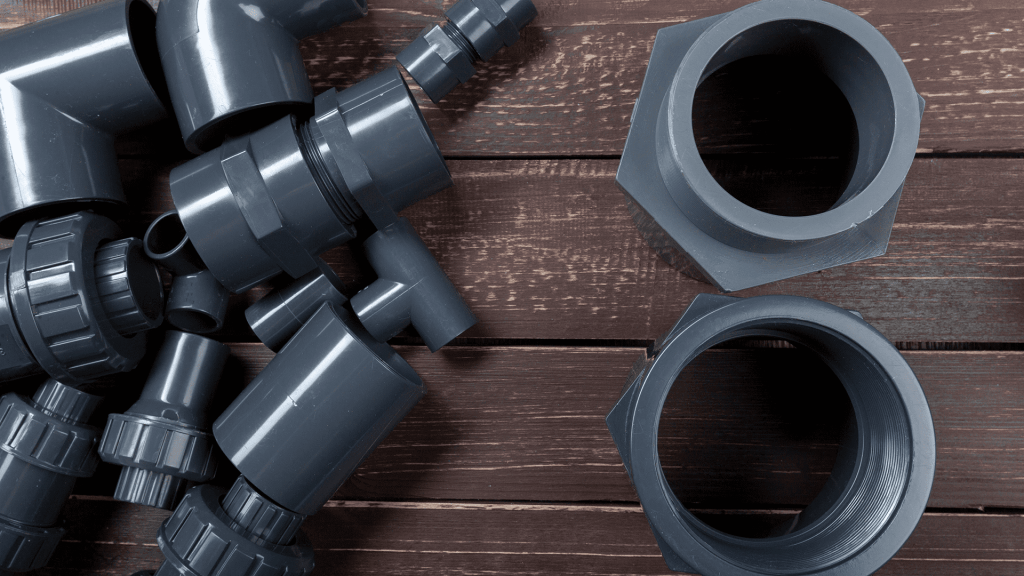
Advantages of Upgrading a Drain Line
Upgrading or installing a new sewer line brings numerous benefits, especially for those still contemplating the move. Here are some advantages to consider:
- Enhanced Reliability: Modern materials and technologies used for sewer lines offer superior resistance to external factors, ensuring longevity.
- Cost Efficiency: While the initial investment for an upgrade might appear significant, it proves cost-effective in the long run, decreasing future repair and maintenance expenses.
- Improved Efficiency: A new system ensures a more efficient wastewater flow, preventing issues like blockages or backflows.
- Environmental Conservation: Modern systems offer better wastewater treatment, reducing pollution and its impact on the environment.
- Property Value Increase: An advanced and efficient sewer system can substantially boost the market value of your property.
- Protection Against Tree Roots: Updated pipes often feature protection against the intrusion of tree roots, which can damage older sewer systems.
- Comfort and Hygiene: Issues like unpleasant odors, overflows, and other problems associated with inefficient or outdated systems will disappear.
If you haven’t yet implemented a sewer system or are deliberating whether to upgrade or install one, take a look at the benefits mentioned above. Investing in a modern sewer system enhances your quality of life but also delivers lasting economic and environmental advantages.
The Process of Installing A New Drain Line
- Location Assessment and Planning
Before beginning the actual installation process, it’s essential to conduct a comprehensive location assessment. By doing this, one ensures that the drain line route and depth are appropriate and avoid unforeseen obstacles.
2. Marking the Area
Once a clear plan is established, the installation area is specifically marked using stakes or spray paint to outline the drain line’s path. This helps to ensure precise and efficient excavation.
3. Excavation Using an Excavator
The next step is excavation, and this is where heavy machinery, like an excavator, comes into play. This machine carefully digs up the ground following the marked lines, creating a trench where drain pipes will be laid. Given the machine’s size, it’s operated by a trained technician. This ensures the trench depth is consistent and in line with the project’s requirements.
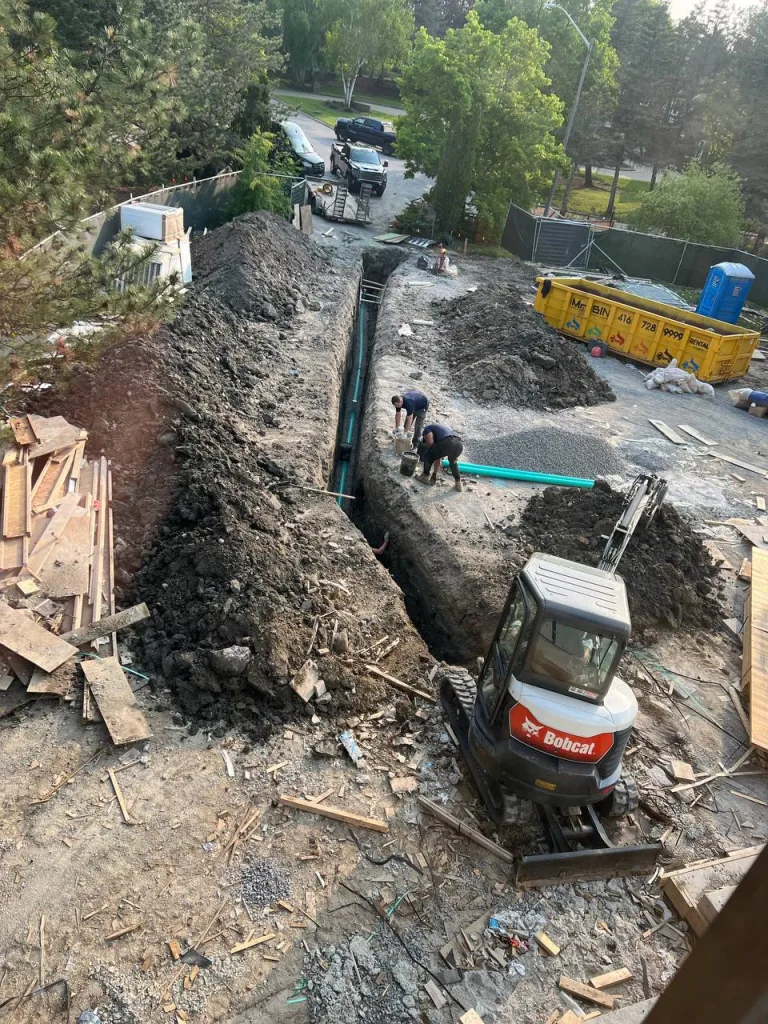
4. Preparing the Trench
After excavation, the trench’s base is often filled with gravel. This step aids in maintaining proper drainage and also acts as padding for the drain pipes, ensuring they don’t come into direct contact with sharp or rough surfaces.
5. Laying the Drain Pipes
The drain pipes are then methodically placed onto the gravel layer in the trench. Each pipe section is carefully connected to the next, ensuring a tight and leak-proof fit.
6. Checking the Slope
Gravity plays a pivotal role in drain line functionality. Hence, it’s crucial to ensure that the pipes possess a very slight slope, helping water flow smoothly without obstructions. A leveling tool or a laser level might be used at this stage to confirm the slope.
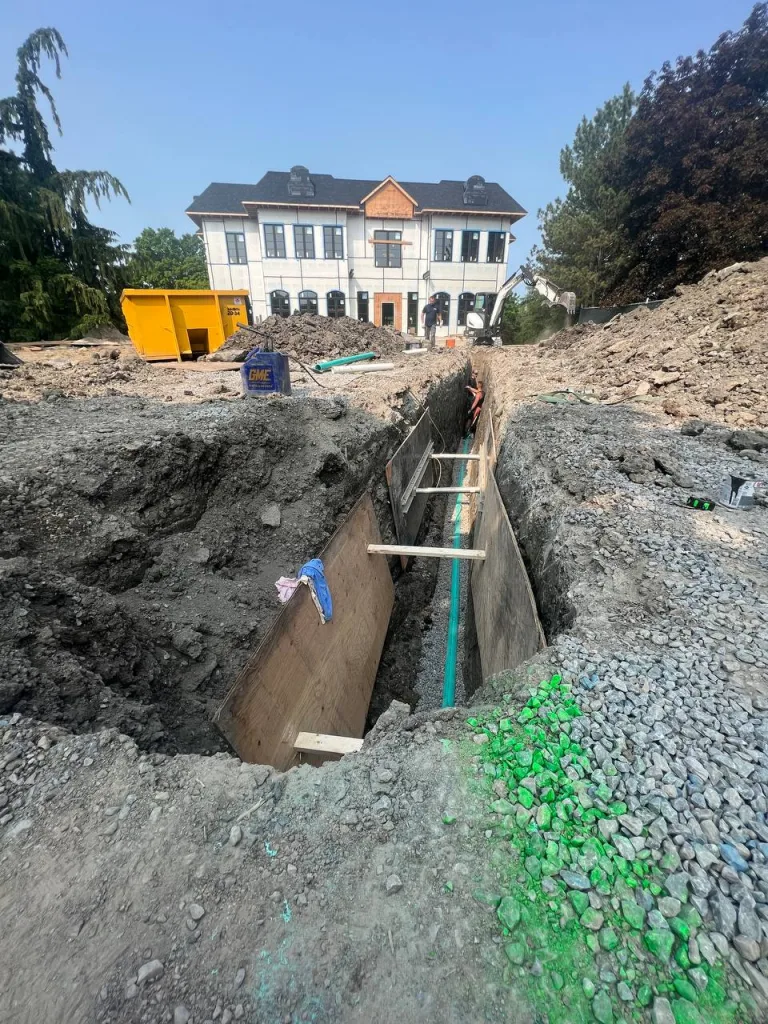
7. Backfilling
Once the pipes are positioned correctly, the trench is gradually filled in. The excavated soil is placed back, compacting it layer by layer to avoid future ground settlement issues.
8. Final Testing
With the installation complete, the installed drain line is tested for functionality. Water is run through the system to verify there are no leaks, and that the flow is smooth and efficient.
9. Location Restoration
Post-installation, the area is carefully cleaned up. Any debris from the excavation is removed, and the ground is leveled. If the area had grass or other landscaping elements, they’re often restored to their original state.
Installing a new drain line is a systematic and precise process that requires the right tools, machinery, and expertise. From using excavators for precise excavation to ensuring the slope is perfect, every step is integral to a long-lasting and efficient drainage system. While the process might seem difficult, with the right team and equipment, it ensures a simple, efficient drainage system for any property.
Conclusion: The Importance of Expertise in Drain Line Installation and Maintenance
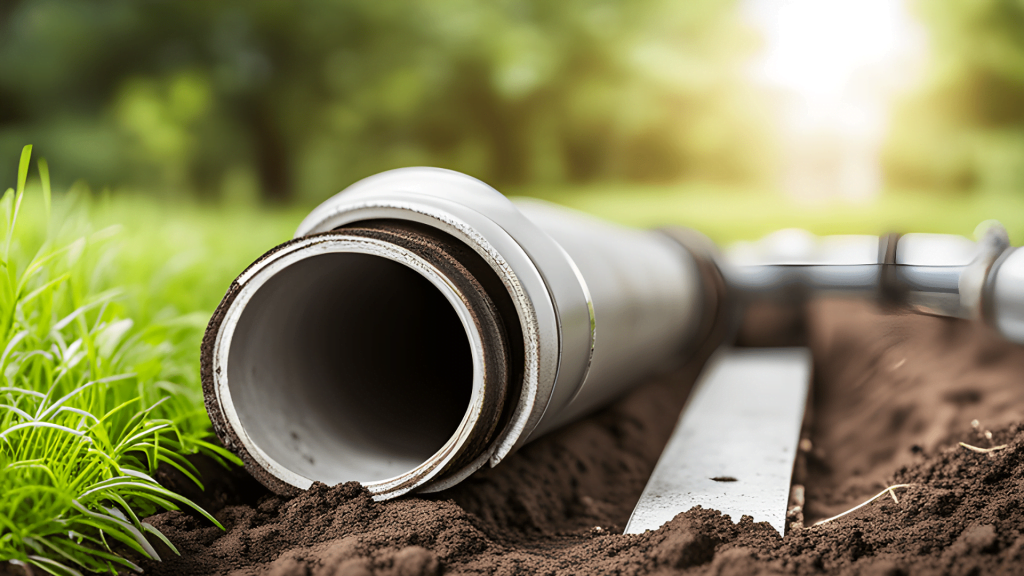
The complexity of drain systems underscores their importance in our urban landscape. From their historical significance in ancient civilizations to their meticulous modern installation process, drain lines have always been crucial for sanitation and effective waste management. The process of installing these lines, marked by detailed assessments, careful excavation using advanced equipment like excavators, precise pipe laying, and thorough testing, demands a degree of expertise that can’t be compromised.
However, understanding the system is only half the battle. Proper installation or upgrades shouldn’t be entrusted to anyone. For such significant tasks, seeking a professional service is not just advisable, it’s essential. The expertise required in ensuring that the lines are accurately placed, the slopes are accurate, and the systems run seamlessly is not ordinary. It requires hands that have done it time and time again, understanding the nuances and challenges that might arise.
In this regard, Water Pro Master Corp stands out as the best in business. Specializing in providing top-tier services for your drainage needs, the corporation understands the process and the importance of ensuring every step is executed perfectly. Investing in professional services like ours guarantees not just the effective functionality of the drain line but also the peace of mind that comes from knowing your system has been handled by the most experienced.
To sum up, while drain systems are foundational to our urban structures, ensuring their optimal operation is foundational to our properties’ well-being. Choose wisely, choose Water Pro Master Corp.

